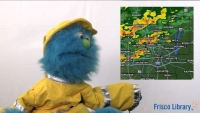Closed Doors/Open Opportunity: Views with Impact
Frisco Public Library, Texas
Innovation Synopsis
When in-person programming stopped, Frisco Public Library rapidly developed a view-catching series of virtual storytime and elementary programs that enhanced access to literacy education in Frisco with over 130,000 views. Development of responsive storytime structures and filming techniques increased views over 150% from traditionally filmed classes.
Challenge/Opportunity
With governor-mandated restrictions on holding in-person events, facilities closed early in the pandemic and reduced access to collections. Children’s librarians faced an existential threat to community literacy support. Additionally, staff had to negotiate socially distant work practices as well as learning new tech skills to keep up-to-date on programming for the new century. After some quick initial success in Facebook Live versions of storytimes, viewership decreased dramatically as quarantining increased.
Key Elements of Innovation
Our quick pivot to online storytimes helped us get data about views and viewing patterns to help modify the structure, length and content of our videos. Purchased tools helped to create a more streamlined look, but those alone are not entirely the reason for success. We balanced click-bait intros with quality content featuring library staff. Our biggest realization was that filmed storytimes were not just a virtual substitute for in-person programming, but a new medium altogether in which to educate.
Achieved Outcomes
We had 150,190 minutes viewed on 117 storytime on-demand videos from the library closing to present. Storytimes that incorporate what we have learned from analyzing metrics have 157% more views than the traditional storytime videos posted. A further lesson learned was about over-production. During the first moments of the quarantine, we produced many more videos that more closely matched our pre-pandemic programming levels. This saturated our social media streams and increasingly depressed our viewing numbers overall.



